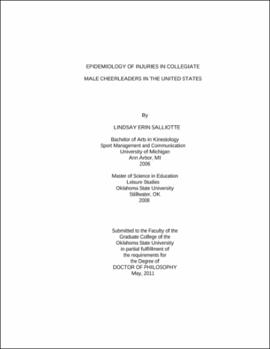| dc.contributor.advisor | Jacobson, Bert | |
| dc.contributor.author | Salliotte, Lindsay Erin | |
| dc.date.accessioned | 2013-11-26T08:34:51Z | |
| dc.date.available | 2013-11-26T08:34:51Z | |
| dc.date.issued | 2011-05 | |
| dc.identifier.uri | https://hdl.handle.net/11244/7557 | |
| dc.description.abstract | Scope and Method of Study: | |
| dc.description.abstract | Injuries in cheerleading have been identified as a significant problem in recent years, however, very little information has been collected about male cheer injuries. The purpose of this study was to describe the epidemiology of cheerleading injuries of collegiate male cheerleaders. This study identifies the most common injuries, mechanism of injuries, and the body part injured. The sample consisted of 89 male collegiate cheerleaders from the United States. Subjects recruited via email or Facebook. Participants voluntarily completed an online questionnaire regarding their cheerleading injury history. Statistical analyses included calculations of 2 tests and Pearson correlations. Frequencies were calculated for the categorical variables. An alpha level of p < 0.05 was used to assess statistical significance. | |
| dc.description.abstract | Findings and Conclusions: | |
| dc.description.abstract | Just over half (48) of the participants reported an injury occurring within the last year. Lower extremity injuries accounted for 40% of the injuries and upper extremity injuries were 36% of the injuries reported last year. Ankle and knee injuries were most common. Forty two percent of the injuries sustained were strains or sprains. Seventy two participants reported at least one career injury. Again lower extremity injuries were most common. Sprains and strains was the most common type of serious injury followed by a ligament or cartilage tear. For both injuries within the last year and the most serious injury stunting was most often the skill being attempted and basing or spotting was the main cause of injury. Most injuries occurred at practice and on a foam floor. There were significant differences among the skill attempted and cause of injury depending on the main skills performed by the participant. The region of the body resulting in injury also differed based on the skill attempted. Overall, the results suggest that male cheerleaders have the same risk and type of injuries occur as female cheerleaders. More research should be conducted on a larger sample to calculate injury rates and include an international population. | |
| dc.format | application/pdf | |
| dc.language | en_US | |
| dc.rights | Copyright is held by the author who has granted the Oklahoma State University Library the non-exclusive right to share this material in its institutional repository. Contact Digital Library Services at lib-dls@okstate.edu or 405-744-9161 for the permission policy on the use, reproduction or distribution of this material. | |
| dc.title | Epidemiology of injuries in collegiate male cheerleaders in the United States | |
| dc.contributor.committeeMember | Gibbs, Lincoln | |
| dc.contributor.committeeMember | Smith, Doug | |
| dc.contributor.committeeMember | Crethar, Hugh | |
| osu.filename | Salliotte_okstate_0664D_11577 | |
| osu.accesstype | Open Access | |
| dc.type.genre | Dissertation | |
| dc.type.material | Text | |
| dc.subject.keywords | epidemiology | |
| dc.subject.keywords | cheerleading | |
| dc.subject.keywords | collegiate | |
| dc.subject.keywords | injuries | |
| thesis.degree.discipline | Health, Leisure and Human Performance | |
| thesis.degree.grantor | Oklahoma State University | |
